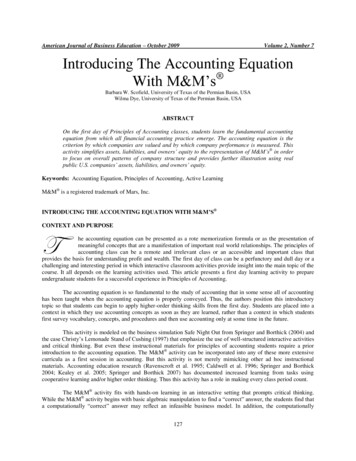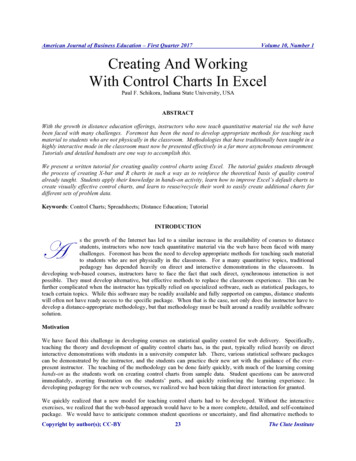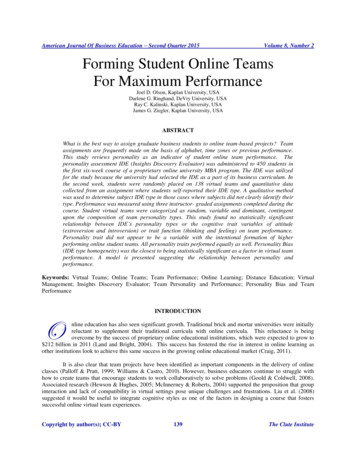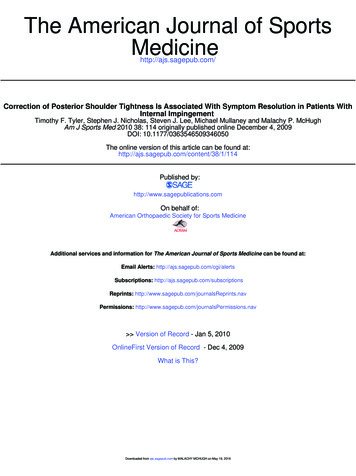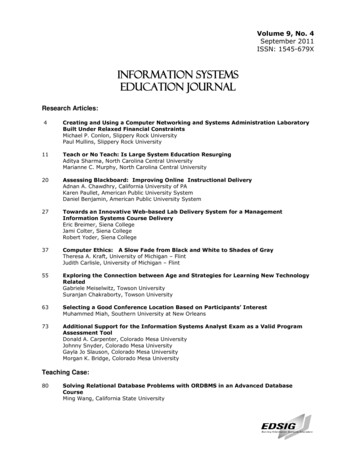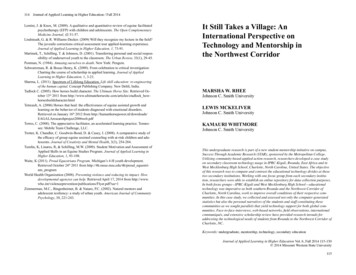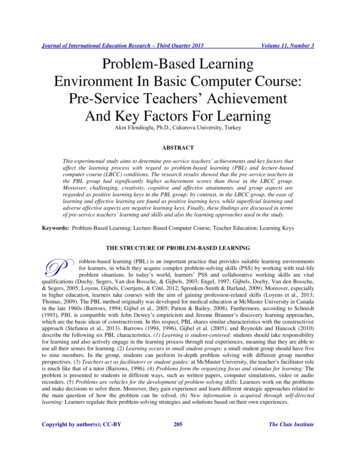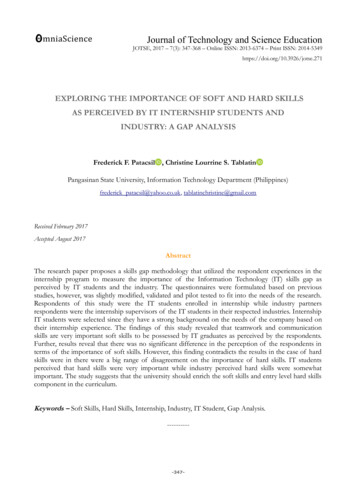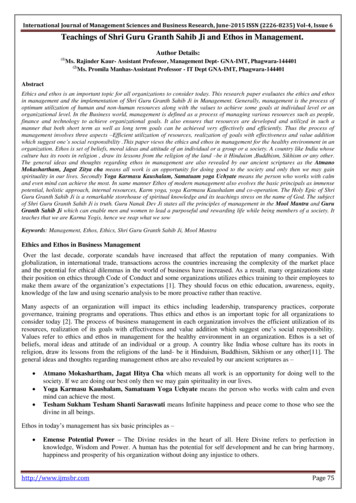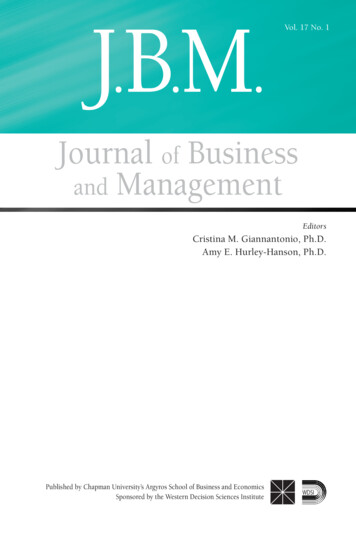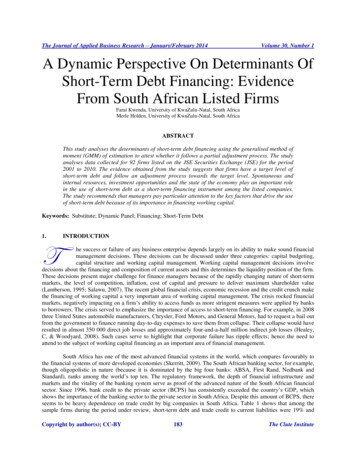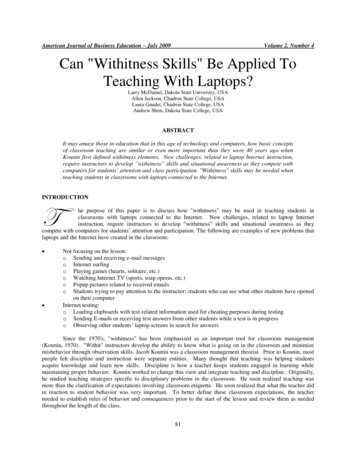
Transcription
American Journal of Business Education – July 2009Volume 2, Number 4Can "Withitness Skills" Be Applied ToTeaching With Laptops?Larry McDaniel, Dakota State University, USAAllen Jackson, Chadron State College, USALaura Gaudet, Chadron State College, USAAndrew Shim, Dakota State College, USAABSTRACTIt may amaze those in education that in this age of technology and computers, how basic conceptsof classroom teaching are similar or even more important than they were 40 years ago whenKounin first defined withitness elements. New challenges, related to laptop Internet instruction,require instructors to develop “withitness” skills and situational awareness as they compete withcomputers for students’ attention and class participation. "Withitness" skills may be needed whenteaching students in classrooms with laptops connected to the Internet.INTRODUCTIONThe purpose of this paper is to discuss how "withitness" may be used in teaching students inclassrooms with laptops connected to the Internet. New challenges, related to laptop Internetinstruction, require instructors to develop “withitness” skills and situational awareness as theycompete with computers for students’ attention and participation. The following are examples of new problems thatlaptops and the Internet have created in the classroom: Not focusing on the lesson:o Sending and receiving e-mail messageso Internet surfingo Playing games (hearts, solitaire, etc.)o Watching Internet TV (sports, soap operas, etc.)o Popup pictures related to received emailso Students trying to pay attention to the instructor; students who can see what other students have openedon their computerInternet testing:o Loading clipboards with test-related information used for cheating purposes during testingo Sending E-mails or receiving test answers from other students while a test is in progresso Observing other students’ laptop screens in search for answersSince the 1970's, "withitness" has been emphasized as an important tool for classroom management(Kounin, 1970). "Withit" instructors develop the ability to know what is going on in the classroom and minimizemisbehavior through observation skills. Jacob Kounin was a classroom management theorist. Prior to Kounin, mostpeople felt discipline and instruction were separate entities. Many thought that teaching was helping studentsacquire knowledge and learn new skills. Discipline is how a teacher keeps students engaged in learning whilemaintaining proper behavior. Kounin worked to change this view and integrate teaching and discipline. Originally,he studied teaching strategies specific to disciplinary problems in the classroom. He soon realized teaching wasmore than the clarification of expectations involving classroom etiquette. He soon realized that what the teacher didin reaction to student behavior was very important. To better define these classroom expectations, the teacherneeded to establish rules of behavior and consequences prior to the start of the lesson and review them as neededthroughout the length of the class.81
American Journal of Business Education – July 2009Volume 2, Number 4All of this came about from an incident that occurred while Kounin was teaching a class in MentalHygiene. A student in the back of the classroom was reading a newspaper with the paper fully open to block anycontact with the instructor. Kounin asked the student to put the paper away and pay attention. Once the studentcomplied, Kounin realized that a number of students who were engaged in unfavorable behaviors stopped and beganto pay attention to the lecture. This created an interest for Kounin in understanding classroom discipline andbehavior and how it relates to student learning. Through Kounin’s observations, he identified what is now known asthe Ripple Effect. According to the Kounin Model, when an instructor interrupts the class due to the misbehavior ofone student, it often influences the behavior of other students as well (Wuest, 1999).Kounin wrote a book "Discipline and Group Management in Classrooms" to summarize the behaviors ofeffective and ineffective classroom managers. He discussed what teachers did to stop misbehavior, but found thatno matter how the teacher handled the situation, it did not change the student’s reaction. He concluded the wayteachers handled misbehavior when it occurs was not the key to successful classroom management. The answer tosuccessful classroom management was in the instructor’s actions prior to the problem behavior. One exampleinvolved a teacher who would flick the lights off and on prior to beginning a lesson. This worked well for her, but inanother classroom setting, flicking the lights had no effect.Kounin carried on his classroom management studies for five years. During that time, he experimentedwith college, high school, and elementary students. He compiled data based on videotape segments taken fromdiverse learning communities. He found that organization and planning of curriculum were instrumental to goodclassroom management, along with a proactive approach to management on the part of the teacher. Through theseactions, higher levels of student involvement were realized. Teachers need to have good lesson movement whichcontributes to the unification of effective management and effective teaching. These principles can be maintainedthrough observation, overlapping, momentum, smoothness, and group focus.For those who supplement classroom instruction with technology via the use of laptop computers, rulesregarding Internet use in the classroom must be developed with consequences that are well defined and enforced.The instructor must engage the students with a wide selection of lessons. By using computer laptops as a tool forlearning, such as note taking and filing information, a number of different learning experiences are offered; thereforea larger number of learning modalities can be addressed.WITHITNESS"Withitness," was a term developed by Kounin (Wuest 1999) to illustrate a teacher's awareness of what wasgoing on simultaneously in the classroom. To the unsuspecting learner, it would seem as though instructors areblessed with a skill indicative of a rare physiological state where they have eyes located at the back of their head.This phenomenon is often recognized when the teacher is in a small group setting, while presenting a topic to thegroup, or when students are working independently. What the learner does not know is that this acquired skill ismanifested through observation. It is not necessary to understand the skills of the teacher; it can all be translated interms of student perception and what the students think of the instructor’s skill.With laptops and lessons that make use of available technology, the instructor may find that teaching in theback of the room is more effective than in the front. The instructor in the back of the room can observe whatstudents have opened on their computers. It is important for instructors to work on the perimeter of the roomexposing their back to as few students as possible or for the shortest period of time. Enforcement of rules, includingInternet and laptop use, should be consistent. Instructors must be highly organized to maintain students’ interest.OVERLAPPINGKounin described overlapping as attending to two or more events at the same time. The ability to attend tomultiple things at the same time may include giving a lecture to open a new topic, while patrolling the room toprevent student misbehavior. This is closely related to withitness and Kounin felt one without the other wouldreduce effectiveness. The concept of instructors’ multi-tasking is extremely important while competing with theInternet when the students are required to use laptops. This type of instructional practice involves teaching while82
American Journal of Business Education – July 2009Volume 2, Number 4observing computer screens. It sometimes necessitates the instructor to request that students lower their laptopscreens so the instructor can make eye contact with the learners.MOMENTUMMomentum involves the flow of the lesson. Not only does the teacher need to know what is going tohappen next, but he must be prepared for unexpected changes, such as the loss of Internet connection or whilereprimanding a student who is not involved in the lesson. Maintaining high levels of student interest andengagement may be challenged by a number of occurrences such as;When students experience satiation or boredom, other behaviors emerge. Students may introduce variations into thetask, work mechanically on the task without giving it much thought, or try to create some excitement through foolingaround with a classmate or engaging in other forms of misbehavior. Kounin suggests reducing satiation byproviding students with a feeling of progress, offering students challenges throughout the lesson, and beingenthusiastic. Variety reduces satiation and alleviates boredom. Changing the level of challenges, restructuringgroups, extending the task, and using different teaching styles add variety to the lesson (Kounin, 1970).SMOOTHNESSMaintaining direction in the lesson and not losing focus or being diverted by irrelevant information can beaccomplished by letting students know what is going to happen in class on a particular day and sticking to it.Classroom consistency involves the transitioning from one learning activity to another without a lot of disruption.Instructors should avoid the "jerkiness" of going from one task to another without direction; this may include “flipflops” where the instructor closes one subject, begins another and then jumps back to the previous subject. Kouninsuggests that instructors avoids "dangles," interruptions, or inadvertently leaving something unfinished and returninglater. He also suggested teachers minimize truncation. This is experienced when the teacher is interrupted, leavesthe topic and fails to return to it (Kounin). Instructors need to have transitions ready for Internet use. The use ofcomputers for classroom instruction can be immensely valuable while offering lessons that require multimediacomponents, such as word documents, URLs, or more than one Internet site to be used during the learningexperience.GROUP FOCUSThe focus of any educational experience involves student engagement. To one who has not experimentedwith technology in the classroom, it can be a daunting task to keep the entire class significantly involved. Lessonsneed to be well thought out, while the presentation needs to be stimulating to evoke high levels of interest. Studentsare enticed into the learning experience through careful planning and a basic concept of instructional design. Withthese carefully thought out principles, students are less likely to try and find other avenues of interest. Instructorsmust make them accountable for their behavior without disruptions to the entire class. Preparation and planningInternet usage is a critical element for student focus.BEHAVIOR TECHNIQUESWithitness involves the teacher's ability to know what students are doing in the classroom at all times. Italso includes stopping behavior problems before they begin. The teacher should: Always be alert to sights and sounds in the classroom.Arrange the seats so that students are always within eyesight.Scan the room while working with individuals or small groups of students. When helping an individualstudent, make sure that you do not have your back to the rest of the class.Briefly acknowledge misbehavior at first detection; let the class know that you know. Do not letmisbehavior escalate before action is taken.Overlapping: The teacher's ability to effectively handle two classroom events at the same time instead ofbecoming engrossed in one event and letting the other actions occur due to neglect.83
American Journal of Business Education – July 2009 Volume 2, Number 4When instructing one group, the teacher should be able to acknowledge difficulties students outside of thegroup may be having so that instruction continues to flow smoothly. This includes handling distractionsfrom outside the classroom.Ripple Effect: Kounin believed how a teacher handles one student's misbehavior influences the otherstudents who are not misbehaving and promotes good behavior.Desist: When a teacher reprimands one student and other students stop their inappropriate behavior.Smoothness: The teacher's ability to smoothly transition between learning activities.Teachers should: Preplan the lesson so that extraneous matters are realized and taken care of ahead of time. Supplies for theclass should be preorganized before class begins. These materials should be close to location where theywill be used.Once students are engaged in their work, the instructor should not distract them. Instructors should leavestudents to their work and assist students with questions or needs.Momentum: The teacher's ability to have steady movement or pacing throughout a lesson. If a class hasmomentum, the teacher should: Keep the lesson briskly moving.Not dwell on a minor or previously understood concept.Correct students without nagging and quickly return to the lesson.Have students move from one activity to the next without being forced to wait for other students or the nextstep in lesson transition.Group Alerting: The teacher's ability to keep all students actively participating and to create suspense orinterest. It includes: Calling on students at random by asking a question only after scanning the room to make sure students arepaying attention.Raising group interest by interspersing suspense between questions.Having the entire class respond in unison.Being mobile and asking students to show what they have done.Asking one student to respond and look at others.CONCLUSIONIt may amaze those in education that in this age of technology and computers, how basic concepts ofclassroom teaching are similar or even more important than they were 40 years ago when Kounin first defined th
Jacob Kounin was a classroom management theorist. Prior to Kounin, most people felt discipline and instruction were separate entities. Many thought that teaching was helping students acquire knowledge and learn new skills. Discipline is how a teacher keeps students engaged in learning while maintaining proper behavior. Kounin worked to change this view and integrate teaching and discipline .
